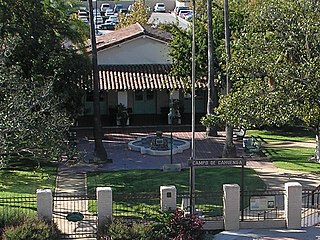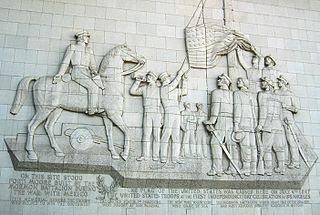 W
WThe California Campaign (1846–1847), colloquially the Conquest of California or Conquest of Alta California by the United States, was an early military campaign of the Mexican–American War that took place in the western part of Mexico's Alta California Department, in the present-day state of California. The California Campaign was marked by a series of small battles throughout 1846 and early 1847.
 W
WThe California Republic, or Bear Flag Republic, was an unrecognized breakaway state from Mexico, that for 25 days in 1846 militarily controlled an area north of San Francisco, in and around what is now Sonoma County in California.
 W
WThe Army of the West was the name of the United States force commanded by Stephen W. Kearny during the Mexican–American War, which played a prominent role in the conquest of New Mexico and California.
 W
WThe California Republic, or Bear Flag Republic, was an unrecognized breakaway state from Mexico, that for 25 days in 1846 militarily controlled an area north of San Francisco, in and around what is now Sonoma County in California.
 W
WThe California Republic, or Bear Flag Republic, was an unrecognized breakaway state from Mexico, that for 25 days in 1846 militarily controlled an area north of San Francisco, in and around what is now Sonoma County in California.
 W
WThe Campo de Cahuenga, near the historic Cahuenga Pass in present-day Studio City, California, was an adobe ranch house on the Rancho Cahuenga where the Treaty of Cahuenga was signed between Lieutenant Colonel John C. Frémont and General Andrés Pico in 1847, ending hostilities in California between Mexico and the United States. The subsequent Treaty of Guadalupe Hidalgo of 1848, ceding California, parts of Colorado, Nevada, New Mexico, and Arizona to the United States, formally ended the Mexican–American War. From 1858 to 1861 the Campo de Cahuenga became a Butterfield Stage Station.
 W
WThe Mormon Battalion was the only religious unit in United States military history in federal service, having been recruited solely from one religious body and having a religious title as the unit designation. The volunteers served from July 1846 – July 1847 during the Mexican–American War of 1846–1848. The battalion was a volunteer unit of between 534 and 559 Latter-day Saint men, led by Mormon company officers commanded by regular U.S. Army officers. During its service, the battalion made a grueling march of nearly 2,100 miles from Council Bluffs, Iowa, to San Diego, California.
 W
WRancho Las Camaritas was an Alta California 18.57 acres land grant to José de Jesús Noé on January 21, 1840 by Governor Juan Bautista Alvarado. Millions of acres of California land was given at no charge to men between 1784–1846 by the Spanish (1784–1810) or Mexican governments (1819–1846) mostly for military service to raise cattle on. About 300 of the 800 Land grants were sizable varying from a few thousand to 1.5 million acres – see List of ranchos of California for the larger grants. Following the Mexican–American War, the land grants were challenged with most of them falling into American hands. Only one land grant has remained undeveloped. Las Camaritas' ownership was disputed in court by the U.S. government from 1856 until 1882 due to conflicting documentation presented by its American owner Ferdinand Vassault after a string of sales initiated by Jose Noe sometime between 1842–46.
 W
WThe Treaty of Cahuenga, also called the "Capitulation of Cahuenga," ended the fighting of the Mexican–American War in Alta California in 1847. It was not a formal treaty between nations but an informal agreement between rival military forces in which the Californios gave up fighting. The treaty was drafted in English and Spanish by José Antonio Carrillo, approved by American Lieutenant-Colonel John C. Frémont and Mexican Governor Andrés Pico on January 13, 1847 at Campo de Cahuenga in what is now Universal City, California.
 W
WYerba Buena was the original name of the settlement that later became San Francisco, California. Located near the northeastern end of the San Francisco Peninsula, between the Presidio of San Francisco and the Mission San Francisco de Asís, it was originally intended as a trading post for ships visiting San Francisco Bay. The settlement was arranged in the Spanish style around a plaza that remains as the present day Portsmouth Square.